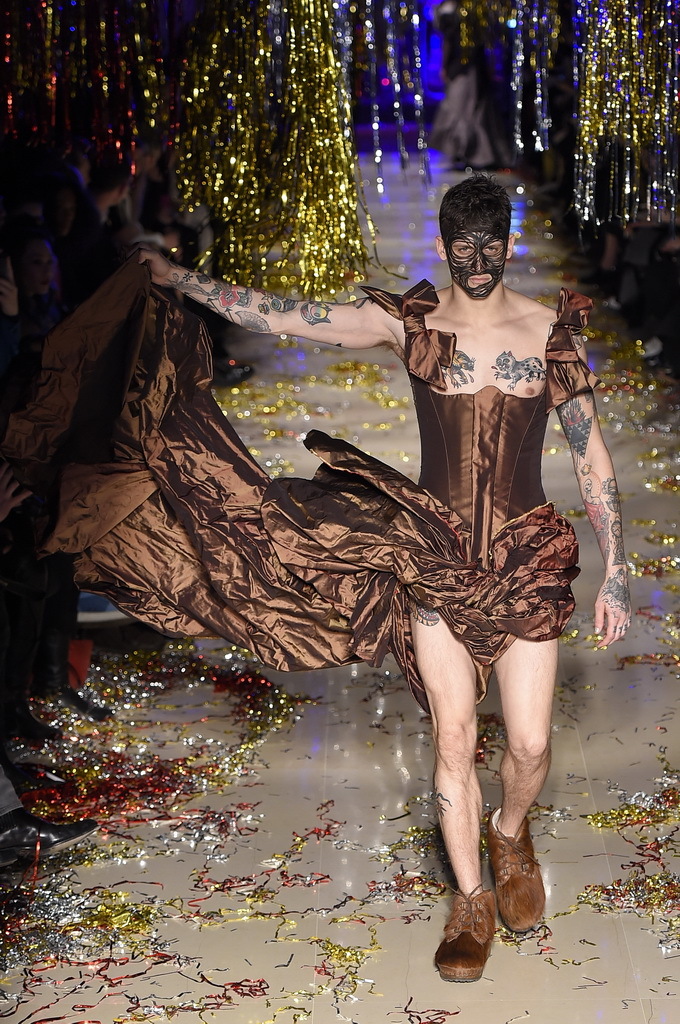“Male and female needs have never been closer,” said Iris Marchand, co-founder of Maison Marchand Moustafa, a French, genderless brand that launched at Paris Fashion Week this season. After years of buying small sizes in the men’s departments, Marchand yearned for designs that “wouldn’t be so aggressively gendered.” The first collection is inspired by boxing uniforms, which, like most sportswear, are naturally unisex. The pieces are streamlined and customizable, with waists crafted to be worn high or on the hips, and hemlines to be folded. “The idea was to create flexible products that you can make your own whoever you are. This wasn’t so much about making a grand statement but about offering simple, intelligent pieces,” she added.
The idea of unisex is not new – neither is men and women re-appropriating each other’s traditional codes; from David Bowie’s love of sequins to Katherine Hepburn’s notorious suits, this audacious approach to gender has always been challenging, especially when celebrities have taken it, transgressively and shocking, into the mainstream. Who can forget Boy George’s Top Of The Pops performance of Do You Really Want To Hurt Me? that famously had newspaper headlines asking whether he was a boy or a girl?
Nevertheless, today, another debate is rumbling: maybe it’s time we move past the reductive gendering of an item like “boyfriend jeans” and “man bags” and towards clothing lines that offer single, genderless collections that fit both the needs and body types of men and women. Maybe unisex will become a durable commercial reality rather than a merely utopian concept? As more and more brands send models of both sexes down the runway, a novel, symbiotic territory is slowly being conquered – populated by softened masculine lines and no-frill feminine cuts.
“Trousers for women, yes! Dresses for men, the same dresses that women wear? Do that! It takes a lot of trial and error. Dresses without a woman’s waist!” said Dame Viv in the notes for her fall/winter 15 show, that saw men take to the catwalk, in yes, dresses for men. Whilst Neil Barrett told i-D after his presentation this season, about how his menswear and womenswear “become one story rather than being men’s pieces or women’s. I’ve always done men’s for women, but I somehow feel it’s gone beyond androgyny.”
To Rad Hourani, a pioneer who launched his eponymous haute couture unisex label in 2007, classical categories don’t apply to a modern society. “We live in a technological world where you can be anywhere at anytime, which has made us more of aware that boundaries between nations, races, gender are man-made. Today more than ever, we realize how violent boundaries can be”he told i-D. His dark, sharp cuts are also intricately constructed to fit both sexes: before launching his brand, he took a year to study human anatomy and develop patterns that fit “all genders, forms and shapes”. This consists of, for example, merging a classical man and woman’s design into one, or developing, long straight shapes.
From mid-March, his creations will be showcased at Selfridges’ genderless pop-up concession Agender, alongside other projects of similar inclinations. Sprawling over three floors, the project will also include Nicola Formichetti’s queer and kawaii label Nicopanda, a capsule by 80s wunderkind BodyMap, and brands such as Gareth Pugh and Ann Demeulemesteer. The space, designed by Faye Toogood (who has collaborated with fashion houses such Alexander McQueen and Comme des Garçons), encapsulates a fully neutral experience, complete with white canvas used as wrapping paper in order for shoppers not to feel labelled.
“Fashion is the direct and uncensored reflection of our society. So today’s interest for gender-neutral clothes is a way to be part of a society with equal rights and opportunities for both sexes” said Stephanie Hahn, founder of label 22/4, that creates two almost identical collections for both genders with small adjustments for a larger or smaller frame, looking to blur stylistic and social frontiers.
This fight for equality reflects a wider struggle, notably in education: after Sweden’s attempt to neutralize teaching and eradicate discrimination, various school in Nebraska too are offering genderless classes. This includes not referring to children as ‘boys and girls’, and grouping them by age, or alphabetical order rather than sexes.
One challenge does remain in fashion: “Although this trend translates to sales, it is largely driven women buying men’s collections, rather than the other way round” said Guillaume Salmon, the spokesperson for Parisian store Colette – so while boyfriend jeans have become an ubiquitous bestseller, we have yet to see men’s high street labels offering the girlfriend skirt.
Credits
Text Alice Pfeiffer
